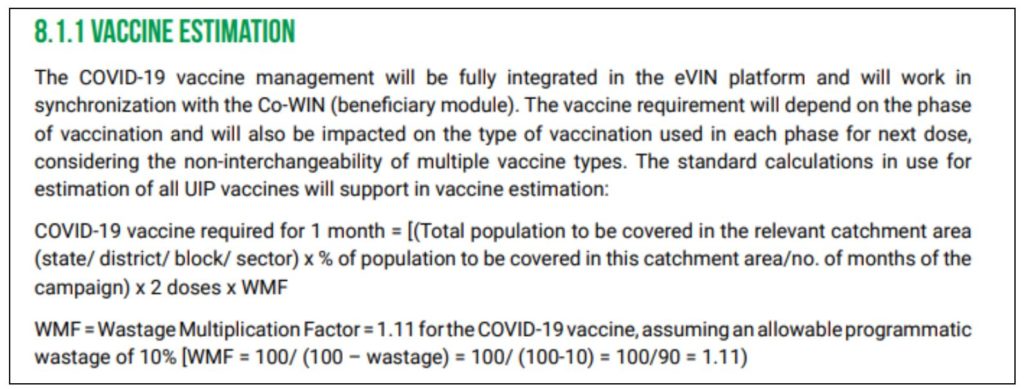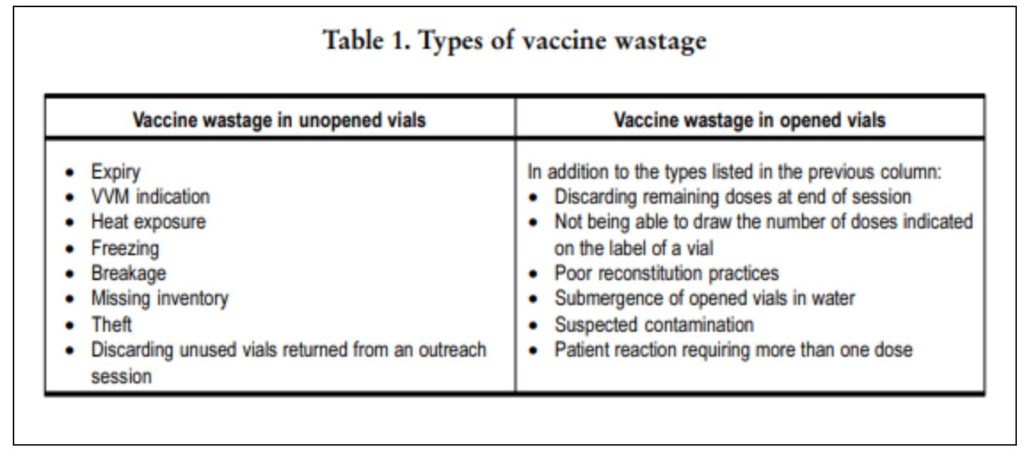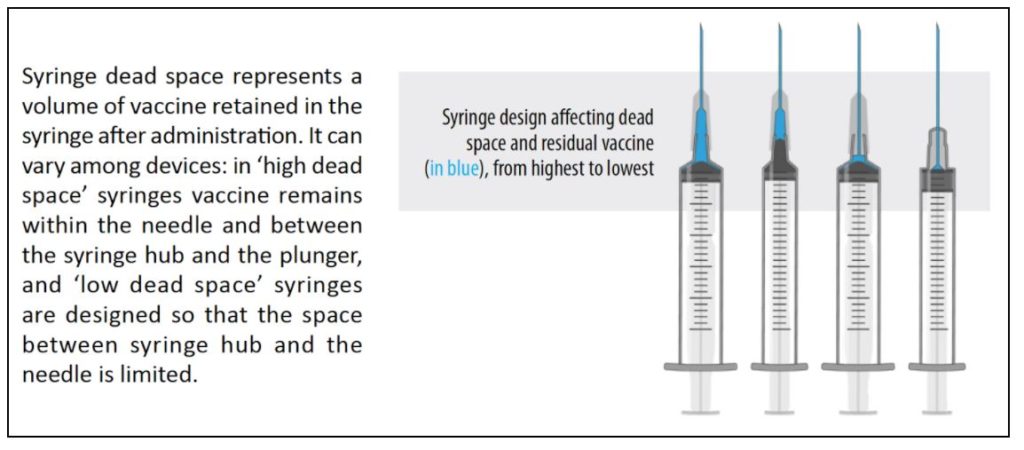The Union Government has multiple times referred to ‘Vaccine Wastage’. But what exactly is ‘Vaccine Wastage’? How does it occur? Is there a way to prevent it? How is Wastage factored in for supply estimates? This explainer has all the answers.
One of the key measures to fight the COVID-19 pandemic that has shaken the world is vaccination. Vaccination is not only known to help reduce the severity of the disease but also prevent transmission. However, the shortage of vaccines is a problem that many countries are grappling with because of the sheer volume of the vaccines required to protect the entire population. Though production capacities are being maximized in order to ensure an adequate supply of COVID-19 vaccines, the task is herculean since billions of people have to be vaccinated in the shortest possible time as COVID-19 has already claimed about 3.8 million lives globally as of 09 June 2021.
Along with supply-side issues, ‘Vaccine Wastage’ is another problem that countries have to deal with since such wastage has to be factored in forecasting needs. Though some wastage is inevitable in any vaccination program, that too in such a large-scale vaccination effort like COVID-19, reducing the wastage holds the key.
The Indian Health Ministry made wastage of vaccine, one of the criteria for allocation of vaccines to states. Time and again, health officials and even the Prime Minister have called for avoiding the wastage of vaccine doses. But what exactly is vaccine wastage? How does it occur and how can wastage be minimized? We look at all such issues in this explainer.
Some Vaccine wastage is inevitable
Vaccine wastage is the sum of vaccines discarded, lost, damaged, or destroyed. It takes place through loss by use, decay, erosion, or leakage or wastefulness. It is an expected component of large vaccination drives as it cannot be avoided. However, if the wastage is high, it will have repercussions on the costs as a significant portion of immunization program costs is that of vaccines. High wastage results in excessive demand and this pose a challenge when production is limited as the demand cannot be met easily as is happening in the case of COVID-19. People will have to wait longer, and the government will have to spend more on vaccine procurement and supply chain in case of increased wastage.
Vaccine estimation is based on ‘Vaccine Wastage Rate’
During procurement of vaccines from the manufacturer, an estimated wastage is also considered as vaccine coverage should not get jeopardized. It is important to calculate the wastage rate as it helps in reducing stock-outs and over-stock. Further, estimations also aid in choosing appropriate vaccine presentation & immunization session size and preparing a supply chain infrastructure accordingly. Globally, the vaccine wastage rate is used for estimating the number of vaccine doses to be procured.
Vaccine wastage is directly related to vaccine usage. Vaccine usage is calculated as the proportion of vaccine issued which is administered. The vaccine wastage rate is defined as ‘100 minus the vaccine usage rate’ as per the WHO definition.

Vaccine Wastage Factor indicates how much additional vaccine should be ordered
The wastage rate is used to determine the ‘wastage factor’ which is necessary to accurately plan vaccine needs. The vaccine wastage factor indicates how much additional vaccine should be ordered in order to allow for the given wastage rate and is calculated as 100 divided by the vaccine usage rate.

The ‘Vaccine Wastage Factor’ gives the authorities a fair idea of the additional doses to be ordered in order to cover the target population.
10% programmatic wastage of COVID-19 vaccine is taken in India
According to the Health Ministry’s guidelines on COVID-19 vaccination in India, the vaccine requirement will depend on the phase of vaccination and will also be impacted on the type of vaccine used in each phase for the next dose, considering the non-interchangeability of multiple vaccine types. India’s monthly COVID-19 vaccine requirement is estimated as-
COVID-19 Vaccine required for 1 month = [(Total population to be covered in the relevant catchment area (state/ district/ block/ sector) x % of the population to be covered in this catchment area/no. of months of the campaign) x 2 doses x Wastage Multiplication Factor (WMF).
A Wastage Multiplication Factor (WMF) of 1.11 has been taken, assuming an allowable programmatic wastage of 10%. That is,
WMF = Wastage Multiplication Factor = 1.11 for COVID-19 Vaccine;
WMF = 100/(100 – Wastage) = 100/(100-10) = 100/90 = 1.11.
The Union Government is estimating the vaccines required considering at least 10 percent of programmatic wastage. This implies that if 100 vials are needed, the stock demand will be 110 vials under the assumption that 10 vials may get wasted. The wastage rate assumed for vaccines against diphtheria, pertussis, and tetanus (DPT), Tetanus, Polio, Hepatitis-B, and Pneumococcal Conjugate Vaccine is also 10%, while that for BCG vaccine is 50%.

Vaccine wastage can occur in opened and unopened vials
A broad categorization of vaccine wastage based on occurrence is wastage in ‘opened’ vials and in ‘unopened’ vials. For instance, expiry of vaccine, exposure to heat, breakage, freezing, missing inventory, and theft are wastage that can take place in ‘unopened’ vials and mainly occurs at different levels- in all storage facilities, during delivery/transportation, and at the service level. Wastage in ‘opened’ vials may happen when the remaining doses in the opened vial are discarded at the end of a session, or if the number of doses drawn from the vial is lesser than what can be drawn, or if the reconstitution practices are poor, or based on the individual’s reaction to the vaccine & if more doses are required to vaccinate the individual.

Doses remaining after a certain time of opening the Vial should be discarded
With respect to COVID-19 vaccination, for instance, a vial of Covishield vaccine has to be used within a fixed time period, that is, four hours as per MoHFW’s guidelines (about 6 hours when kept between 2ºC and 8ºC, according to WHO). Each vial has 10 doses of vaccine and so, if 10 people are not available to take the vaccine in the stipulated time period, the leftover doses get wasted. This is a major problem in areas where the vaccine hesitancy is high as all opened multidose vials should be discarded at the end of the immunization session or within six hours whichever comes first, according to MoHFW.
Proper planning, training of healthcare staff, and improved logistics are the need of the hour
Inadequate planning, lack of experience or adequate training for vaccinating staff, poor cold storage and transportation facilities, and population turnout at vaccine facilities are some of the major factors that contribute to vaccine wastage. These are preventable and hence taking the necessary measures to address these problems will help reduce vaccine wastage. Proper planning like usage of vials with earlier expiry date first, and mobilization of people for the vaccination drives at the local level, the opening of vials when the adequate number of beneficiaries are present, giving requisite training to the healthcare workers on drawing and injecting of vaccines, maintenance of cold chain systems and careful transportation, and reducing vaccine hesitancy through addressing concerns of people & misinformation, are some measures which can be taken to address wastage.
Vaccine Vials contain extra doses
In multi-dose vials, there can be a difference between the number of doses indicated on the vaccine label and the actual number of doses that can be withdrawn. This filling of extra dose of vaccine in each vial is done to facilitate administration of the correct number of doses. Judiciously withdrawing accurate vaccine doses from the vial after having withdrawn the indicated number of doses can help administer more doses. This is because overfill for a 10-dose vial can range from 16% to 24% (or 0.58 to 0.62mL fill-volume for a 0.5mL dose) which makes it possible to withdraw 11 or 12 doses of 0.5 mL from a 10-dose vial when a low dead space syringe (space between syringe hub and the needle is limited) is used. However, it is recommended that if an entire accurate dose cannot be withdrawn from a vial, residuals from different vials should not be combined. Furthermore, pre-loading of syringes is not recommended. An accurate vaccine dose must be drawn and administered immediately only when one is ready to vaccinate.

Kerala reported negative wastage by drawing the extra doses
For instance, healthcare workers in Seoul’s National Medical Center of South Korea have inoculated 629 people with 90 vials of Pfizer-BioNTech vaccine as compared to 540 people possible by extracting the extra dose from each vial.
Similarly, in India, the state of Kerala had administered 7.42 million doses though the government had received only 7.34 million doses of vaccine, according to the Chief Minister’s tweet on 04 May 2021, because of extracting the extra dose from the vials.
Reducing wastage and in fact extracting extra doses from a vial is critical in countries like India where a huge population has to be inoculated and in times when the supply is limited.
Featured Image: Vaccine Wastage


